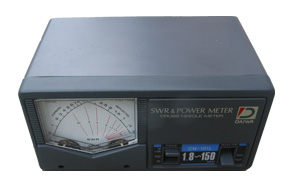SWR METER, HF/VHF + 0.5m Aircell 5 coaxial cable
Valid Article
SWR METER, HF/VHF + 0.5m Aircell 5 coaxial cable
Definition
Measuring device which is placed between a radio and its antenna, and which indicates the SWR (standing wave ratio), i.e. the ratio between the FORWARD POWER (from the radio to the antenna) and the REFLECTED POWER (from the antenna to the radio).
The SWR indicates whether the antenna is properly tuned to the frequency being used, so enabling evaluation of the radio's transmission quality.
The SWR must always be under 3 to avoid burning out the radio.
Specifications
- MSF standards: Daiwa CN-101L
- Frequency: 1,8 -150 MHz, for HF/VHF radio
- Power range: 15 / 150 / 1500 W
- Input/output impedance: 50 ohms
- Input/output sockets: UHF PL, female
- Dimensions: 15.5 x 8 x 10 cm
- Weight: 670 g
- Supplied with an Aircell 5 cable, 50 cm long + UHF PL male connectors
Instructions for use
You are recommended to instal an SWR meter permanently on every base station in order to monitor the installation's quality, but the device is too fragile to be installed permanently in a vehicle.
It can also be used to check the power of a radio.
Use of the SWR meter
When transmitting, the left-hand needle indicates the FORWARD POWER, while the right-hand needle indicates the REFLECTED POWER.
The intersection of the needles indicates the SWR.
Reading the measurements
- The SWR VALUE can be read on the scale at the intersection of the two needles.
- The FORWARD POWER can be read on the left-hand scale. A button allows any of 3 ranges to be selected depending on the power on the transceiver:
- the upper range of 1500 W maximum
- the medium range of 150 W maximum
- the lower range of 15 W maximum
- The REFLECTED POWER can be read on the right-hand scale.
Interpreting the measurements
- The higher the forward power, the better communication will be.
- The lower the reflected power, the less risk there is of burning out the radio.
- The reflected power is dissipated in the radio and can burn it out if it is too high. This is why the SWR must be less than 3. It is also the reason why you should never transmit without an antenna.
CAUTION
If the SWR exceeds 3, stop transmitting immediately and check the installation or inform the logistician in charge of the radio!
(SWR = between 3 and ∞ => destruction of the radio)


![[KCOMZBE0071] MODULE, HF, TRANSCEIVER, BASE (Codan Envoy X1)](/web/image/product.template/566835/image_256/%5BKCOMZBE0071%5D%20MODULE%2C%20HF%2C%20TRANSCEIVER%2C%20BASE%20%28Codan%20Envoy%20X1%29?unique=0478965)
![[KCOMKVHFB50] KIT VHF, TRANSCEIVER, base (Icom ICF5061)](/web/image/product.template/548207/image_256/%5BKCOMKVHFB50%5D%20KIT%20VHF%2C%20TRANSCEIVER%2C%20base%20%28Icom%20ICF5061%29?unique=76b4447)
![[KCOMMHFBSRT] MODULE, HF, TRANSCEIVER, BASE (Codan NGTVR2011)](/web/image/product.template/548147/image_256/%5BKCOMMHFBSRT%5D%20MODULE%2C%20HF%2C%20TRANSCEIVER%2C%20BASE%20%28Codan%20NGTVR2011%29?unique=76b4447)
![[KCOMMVHF11A] module VHF 5 handsets (F3162T) + base (F5061) STANDARD ITEM](/web/image/product.template/547743/image_256/%5BKCOMMVHF11A%5D%20module%20VHF%205%20handsets%20%28F3162T%29%20%2B%20base%20%28F5061%29%20STANDARD%20ITEM?unique=76b4447)
![[KCOMMVHF10A] module VHF 5 handsets (F3062T) + base (F5061) STANDARD ITEM](/web/image/product.template/547816/image_256/%5BKCOMMVHF10A%5D%20module%20VHF%205%20handsets%20%28F3062T%29%20%2B%20base%20%28F5061%29%20STANDARD%20ITEM?unique=76b4447)
![[KCOMKHFBCE1] KIT HF, BASE TRANSCEIVER (Codan Envoy X1)](/web/image/product.template/563142/image_256/%5BKCOMKHFBCE1%5D%20KIT%20HF%2C%20BASE%20TRANSCEIVER%20%28Codan%20Envoy%20X1%29?unique=76b4447)
![[KCOMKVHFB52] KIT VHF, TRANSCEIVER, base (Icom ICF5062D)](/web/image/product.template/557611/image_256/%5BKCOMKVHFB52%5D%20KIT%20VHF%2C%20TRANSCEIVER%2C%20base%20%28Icom%20ICF5062D%29?unique=76b4447)
![[KCOMKVHFB61DP] KIT VHF, TRANSCEIVER, base (Icom IC-F5061DP v1)](/web/image/product.template/566975/image_256/%5BKCOMKVHFB61DP%5D%20KIT%20VHF%2C%20TRANSCEIVER%2C%20base%20%28Icom%20IC-F5061DP%20v1%29?unique=76b4447)
![[KCOMMHFBPRT] MODULE, HF, TRANSCEIVER, BASE (Icom IC-M700PRO)](/web/image/product.template/548151/image_256/%5BKCOMMHFBPRT%5D%20MODULE%2C%20HF%2C%20TRANSCEIVER%2C%20BASE%20%28Icom%20IC-M700PRO%29?unique=95dc555)
![[KCOMMVHF13A] (module VHF 5 handsets (F3262DT)+base (F5061DP) ARTICLES STD](/web/image/product.template/567851/image_256/%5BKCOMMVHF13A%5D%20%28module%20VHF%205%20handsets%20%28F3262DT%29%2Bbase%20%28F5061DP%29%20ARTICLES%20STD?unique=9e0e0a7)
![[PCOMRHFA0D2W7] ANTENNA HF/VHF, 1.5-200MHz, wide-band D2T + 70m coax. cable](/web/image/product.template/546475/image_256/%5BPCOMRHFA0D2W7%5D%20ANTENNA%20HF-VHF%2C%201.5-200MHz%2C%20wide-band%20D2T%20%2B%2070m%20coax.%20cable?unique=c7c6252)
![[PCOMRHFE0AD3] HF ANTENNA folded dipole, 3-30Hz, HF, wideband](/web/image/product.template/546482/image_256/%5BPCOMRHFE0AD3%5D%20HF%20ANTENNA%20folded%20dipole%2C%203-30Hz%2C%20HF%2C%20wideband?unique=e585127)
![[PCOMRHFESSGQ] TUNER (Smartuner SG230) for quadraloop antenna](/web/image/product.template/548782/image_256/%5BPCOMRHFESSGQ%5D%20TUNER%20%28Smartuner%20SG230%29%20for%20quadraloop%20antenna?unique=c7c6252)